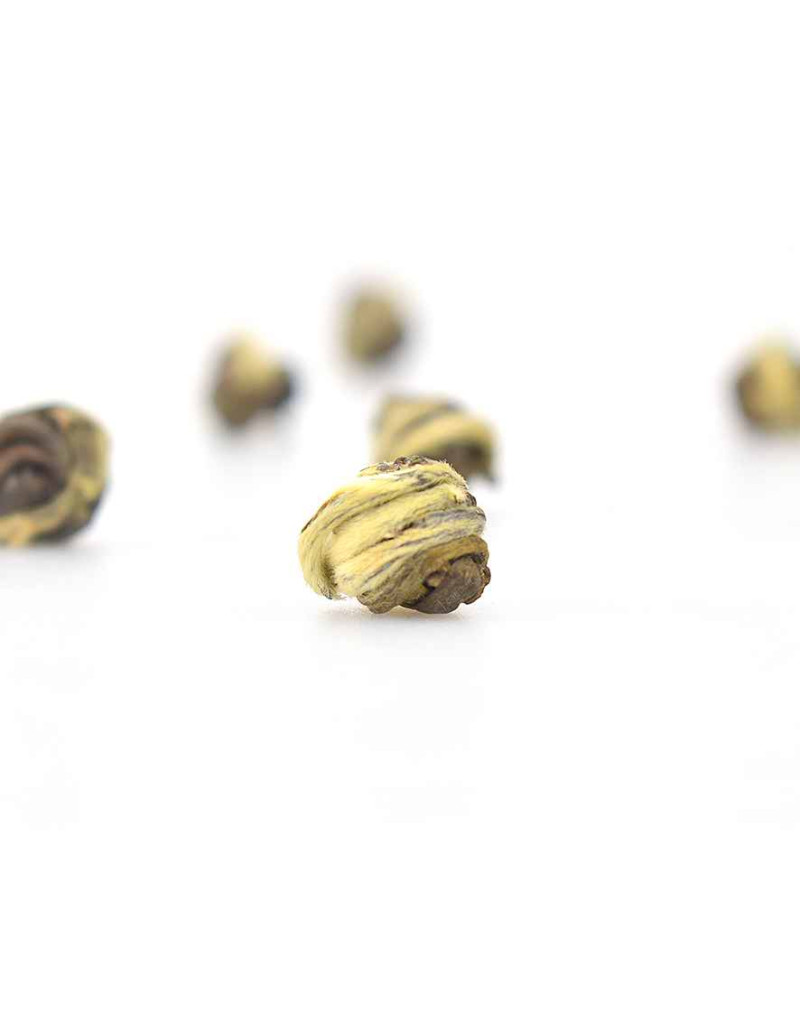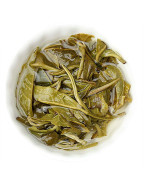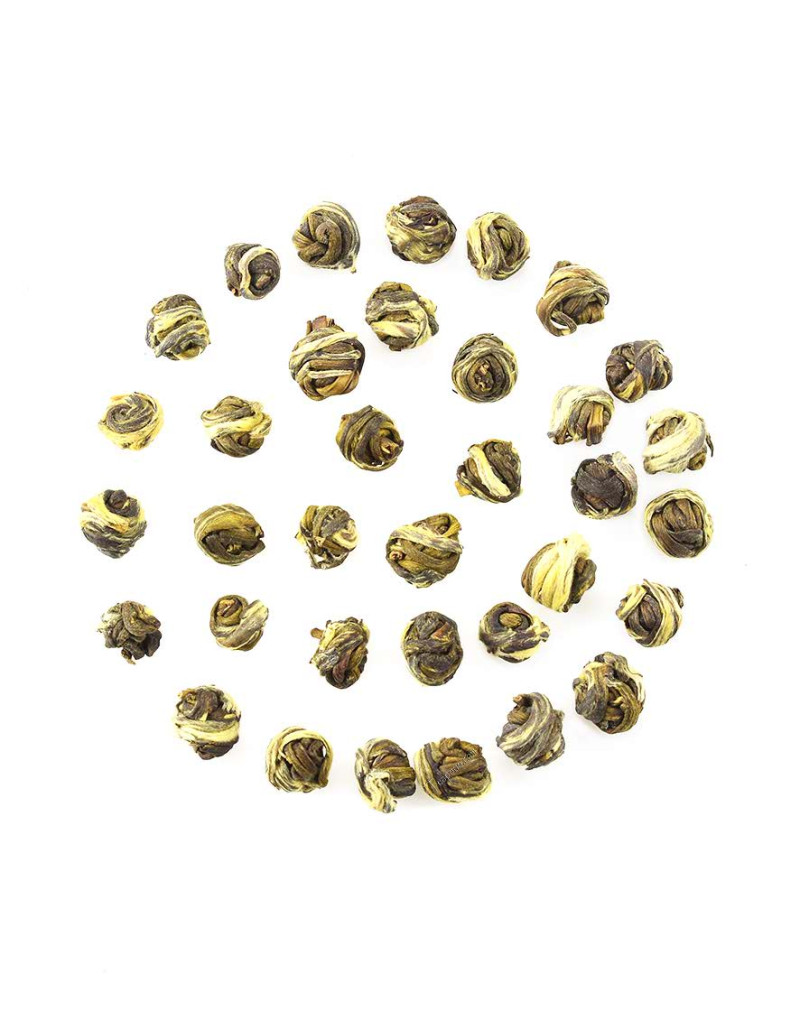Jasmine Dragon Pearl (Moli Longzhu) Scented Green Tea
- Product Code: simple
- Availability: In Stock
Basic Info
Name: Jasmine Dragon Pearl (Moli Longzhu) Scented Green Tea
Other Name: Mo Li Long Zhu
Origin: Yibin, Sichuan Province, China; Jasmine from Guangxi Province
Category: Green tea / Scented tea
Taste & Aroma: Delicate aroma of noble jasmine merged with tea aroma, intense flavour,stunning
Liquor: Slightly yellowish color
Dry Leaf: Little silvery "pearls" , spherical
Harvest Period: Late March (tea), June (jasmine) 2023
Season: Spring tea
Item Form: Tea ball
Ingredients: 100% hand-picked natural jasmine and tea leaves
Shelf Life: 12 -24 months with low temperature storage
Storage: Stored in cool, airtight, opaque containers - refrigeration is recommended.
Tea maker: Lai Yufang
Caffeine: Low
Jasmine Dragon Pearl (Moli Longzhu) Scented Green Tea
Jasmine Dragon Pearl Green Tea is a premium Chinese tea that is made from high-quality green tea leaves and fresh jasmine flowers. This tea is renowned for its delicate floral aroma and flavor, and its beautiful appearance.
If you go to Chengdu, the capital of Sichuan province in the west of China, you will find that almost all teahouse here serves jasmine tea. Jasmine tea is a very popular tea in the southwest and north of China. Because it's very healthy, and it has a strong jasmine fragrance and a soft taste, it has become a star tea that is enjoyed by many people, young and old.
Jasmine tea is a kind of China scented tea with a history of over 1,000 years. It is said that it originated in Fuzhou City, Fujian Province, China.
Jasmine Dragon Pearl Green Tea is a reprocessed type scented tea. Just like our other jasmine tea, it is made by scenting with fresh jasmine flowers several times. Bold yet smooth, this full flavored jasmine green tea tends a mottled and white appearance. When you infuse a Jasmine Ball, you will see the outer leaves uncurl gently. Once the tea ball absorbs enough water, it will bloom like a flower, with long petals on the outside and short petals on the inside.
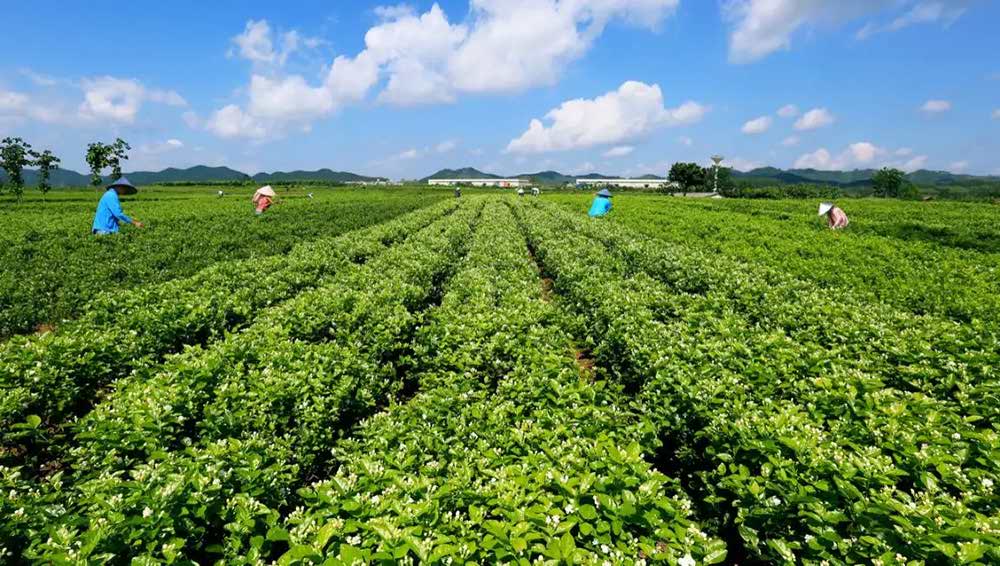
Jasmine Plantations In Hengxian County, Guangxi
Show Full Description
There are several types of jasmine tea in China, our "Jasmine Dragon Pearl Green Tea" tea is one type of the Fujian jasmine tea. It is made with jasmine flowers from the famous Hengxian county in Guangxi and high-quality early spring green tea from Fujian.
To make Jasmine Dragon Pearl Green Tea tea, the leaves of green tea need to be repeatedly scented with fresh jasmine flowers allowing the tea leaves to fully absorb the fragrance and to create a finished tea with a rich long floral finish that lasts through many infusions. The good quality of this tea allows you to fully enjoy the taste and aromas with less tea and shorter steeping times.
More about jasmine tea
History
Technically speaking, jasmine tea can't be classified as one of the six major tea types in China. But it is so influential in China that many people classify it as a green tea, but other people think it belongs to "花茶 scented tea" category. Of course, it is impossible to find a unified view on this issue.Jasmine tea has a history of more than 1,000 years and it is said that the earliest people who made jasmine tea lived in Fuzhou, Fujian Province. Most scented teas are made with roasted green tea because of their good adsorbability, while a small amount of scented teas are made from white, black and even Pu-erh teas.
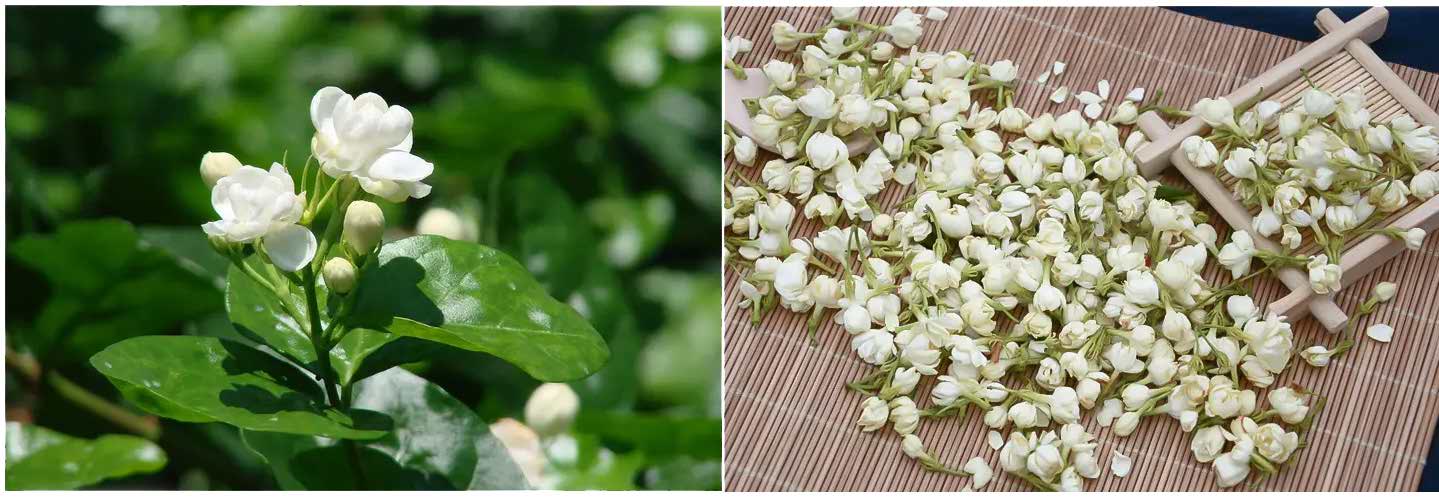
Jasmine flowers
Until today, Fuzhou is one of the major production areas of jasmine in China.Other major producing areas include Fuding, Fujian, Jinhua, Zhejiang, Suzhou, Jiangsu, Ya 'an, Sichuan, Shexian, Huangshan, Hengxian and Chongqing and so on.
So why Fuzhou is the origin of jasmine tea in China? According to the "History" of the Han Dynasty, the jasmine flower first originated in the ancient Roman Empire, and during the Han Dynasty, it reached ancient Persia and Tianzhu through the Maritime Silk Road, and became the sacred flower of Buddhism when it arrived in India, and then spread to Fuzhou with Indian Buddhism.
During the Song Dynasty, there was an upsurge of adding spices to tea in China, because spices were a health care product and traditional Chinese herb medicine, and tea is also a traditional Chinese herb medicine, which can strengthen the body. In Fuzhou dialect, both tea and medicine are called Dao, leading to the combination of incense and tea. In the Song Dynasty, there were dozens of kinds of spiced (scented) tea, but as time went by, only five or six kinds were left, almost all of them were jasmine tea. Thus jasmine tea became popular throughout China. Jasmine tea was first used as a scented tea for dignitaries enjoyment. It began to be commercialized at the end of the Ming Dynasty and was commercialized in large quantities during the Qing Dynasty.

Scenting step
Types of jasmine tea
Jasmine tea can be divided into the following six main varieties according to its origin place: Guangxi, Fujian, Zhejiang, Suzhou and Sichuan.
Characteristics
Jasmine tea is made through complex scenting-blending process. After brewed, jasmine tea can create a bright yellow-green color, fresh and long-lasting aroma, mellow and refreshing taste. It is also rich in nutrients, which is good for health, and the jasmine flowers floating in the tea can bring visual enjoyment to the body and mind.
Production
The process of making jasmine tea is complex and can be broadly divided into the following steps (numerous small technical details are not included):
Process of tea -> Preparation of jasmine flower (picking/cooling/curing/sieving) -> Mixing of tea leaves with jasmine flower (drying/cooling/ventilation/scenting(repeat several times->drying)
Preparation of tea leaves
In order to make scented tea, green tea (sometimes other kinds of tea are also used) should be prepared first, which is later called "tea base", and the process of making this "tea base" is not much different from ordinary green tea. The only difference is that the prepared green tea needs to be shaped into different shapes by hand, such as spheres or rings. It is then dried and stored in preparation for subsequent "scenting-blending" step.
Preparation of Jasmine flowers
A few months after the green tea is made, the jasmine harvest season arrived. Generally speaking, jasmine flowers are harvested in hot summer days. Jasmine flowers usually bloom and release fragrance at night. Therefore, the jasmine flowers used to make this kind of tea are usually picked after 2:00 o'clock in the afternoon, because the jasmine flowers have the largest buds and the best quality at this time of the day. During the transportation of these jasmine flowers, ventilation and temperature control are mainly maintained to prevent the flowers from being burned by the heat generated by breathing. After arriving at the workshop, the jasmine flowers have to go through several steps before they can be used to make jasmine tea.
Mixing (scenting-blending)
The green tea cannot be mixed directly with the jasmine flowers and has to go through several additional steps such as drying,cooling and selecting, etc. After a series of reprocessing, the tea is ready to be mixed with jasmine.
Mix fresh jasmine and dry tea together, so that tea can fully absorb the fragrance released by flowers. This process is called "scenting-blending". In this process, tea makers should monitor six factors: the ratio of flowers to tea, the degree of flowers opening, temperature, humidity, tea layer thickness and stirring time. This step can only be done by experienced workers. After a few hours, the flowers and tea leaves are carefully separated and dried (removing the water the leaves absorb from the flowers) in preparation for the next "flower scenting". This process is repeated more than three times for this grade of jasmine. Every time a new batch of jasmine is used, and the humidity and flower problems of the tea are strictly controlled. The whole process can last from several days to 2-3 weeks.So only experienced workers can complete this tedious task.
To produce Jasmine Dragon Pearl Green Tea, tea artisans handpick only the best tea leaves and carefully process
them to create small, tight balls that resemble pearls. These tea pearls are then scented with fresh jasmine
flowers, which impart their sweet fragrance and flavor to the tea.
Processing steps of Jasmine tea
Jasmine Dragon Pearl Green Tea is a true gem among Chinese teas. Its delicate flavor and beautiful appearance make it a popular choice among tea lovers, and its rich history and cultural significance make it an important part of Chinese tea culture. If you like daily tea with a strong floral fragrance, this tea is worth a try.
| Chinese Gongfu Method | |
| Tea | 4g |
| Water | Gaiwan 3oz / 90ml |
| Time | 5 infusions (15s,40s,1m10s,2m) |
| Temperature | 85℃ / 185℉ |
| Teapot Method | |
| Tea | 6g |
| Water | Teapot (8oz / 240ml) |
| Time | 1- 4mins |
| Temperature | 85℃ / 185℉ |


